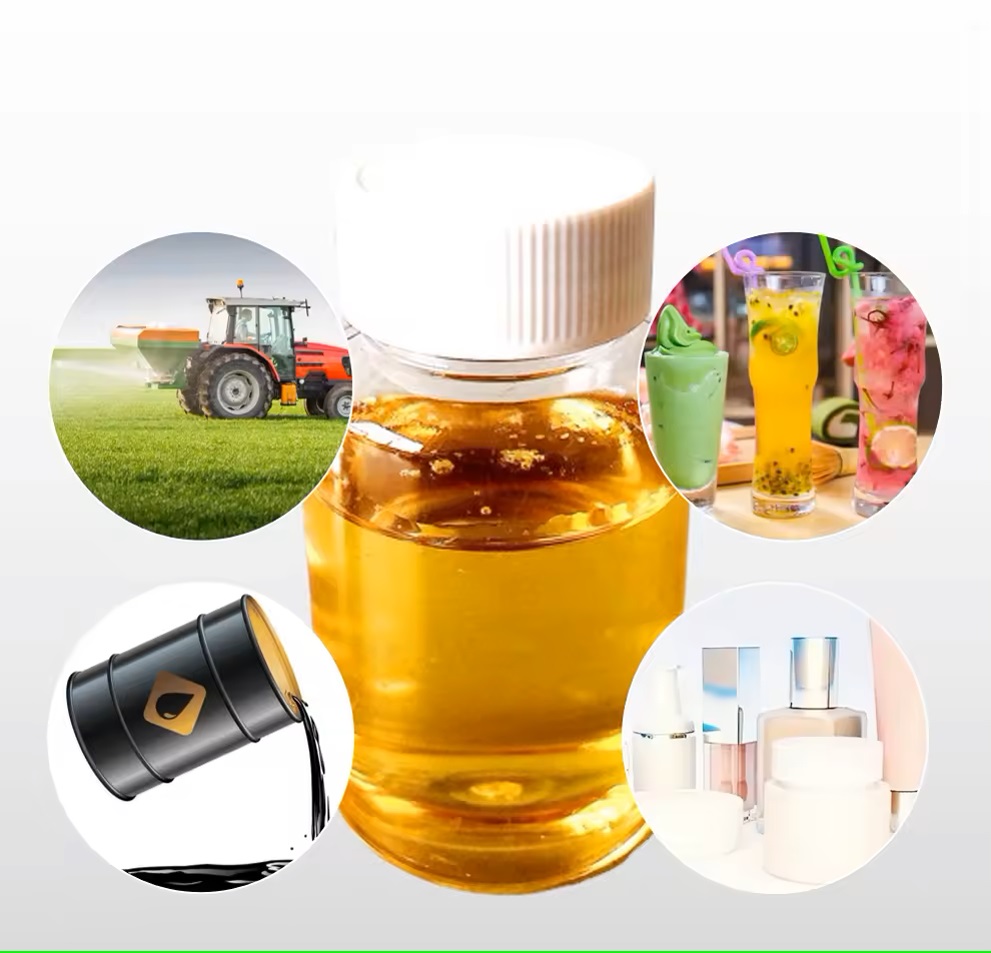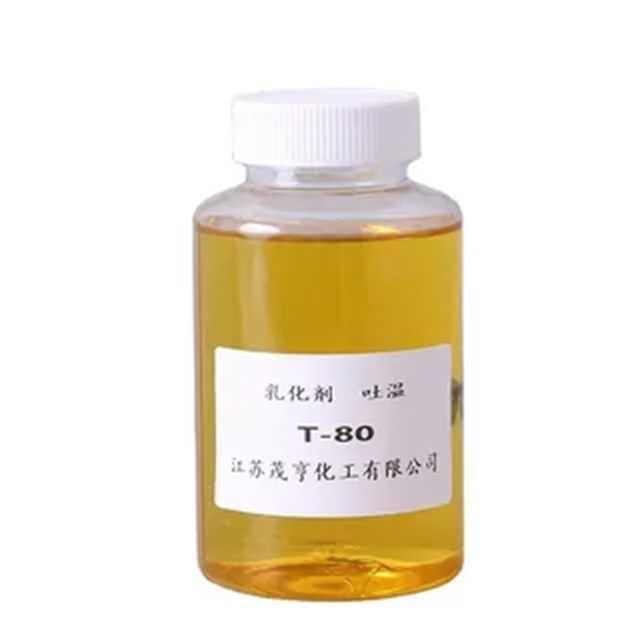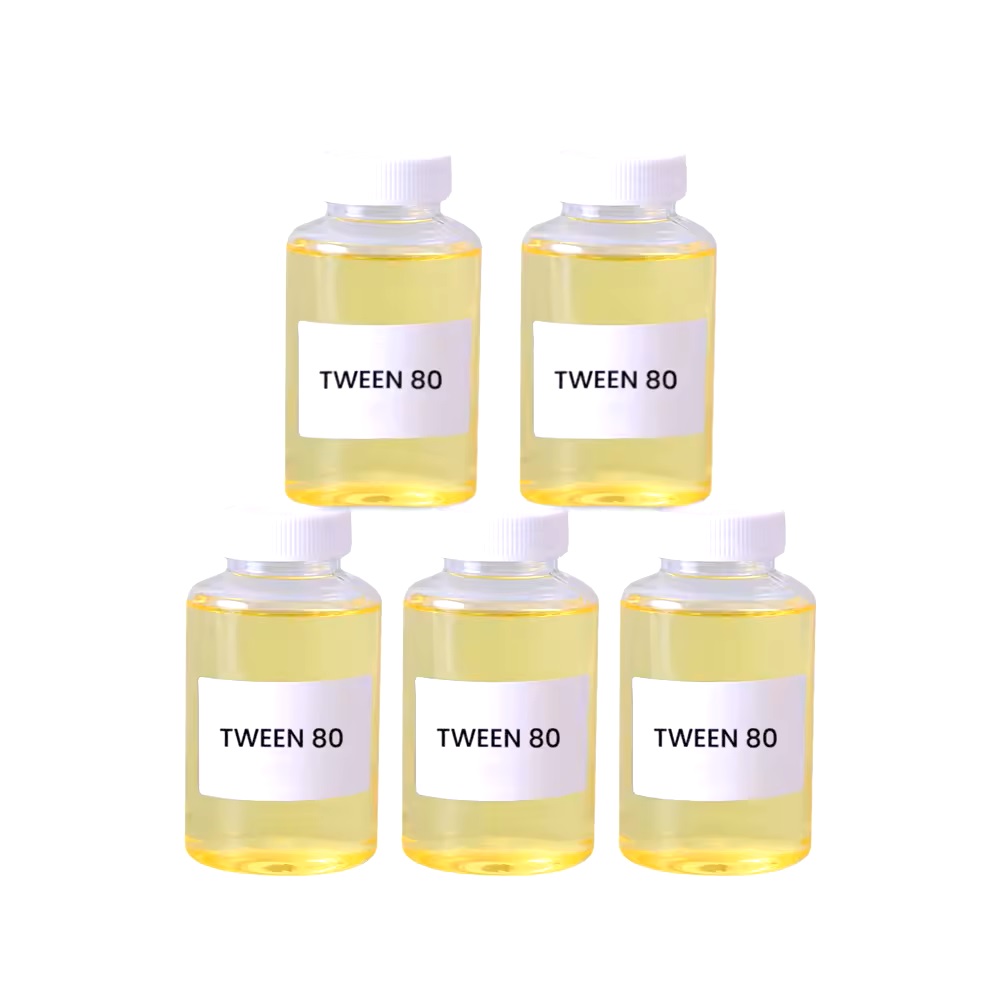We unleash your business potential by maximize the business innovation.
Send EmailPOLYSORBATE 40, Tween(R) 40, TWEEN 40, Emulsifier T-40, POLYOXYETHYLENE SORBITAN MONOPALMITATE, POLYSORBATE 20 40 60 80, 9005-66-7
CAS: 9005-66-7
Molecular Formula: C12H18O11
Names and Identifiers
| Name | Tween(R) 40 |
| Synonyms | Tween-40 TWEEN 40 TWEEN NO 40 Tween(R) 40 POLYSORBATE 40 Emulsifier T-40 POLYSORBATE40,NF POLYOXYETHYLENE SORBITAN MONOPALMITATE POLYOXYETHYLENE (20) SORBITAN MONOPALMITATE Sorbitanmonopalmitat, ethoxiliert, EO 20 mol POLYOXYETHYLENE GLYCOL SORBITAN MONOPALMITATE |
| CAS | 9005-66-7 |
Physico-chemical Properties
| Molecular Formula | C12H18O11 |
| Molar Mass | 338.26472 |
| Density | 1.083g/mLat 25°C(lit.) |
| Melting Point | 0.1 °C |
| Boling Point | 797.89°C (rough estimate) |
| Flash Point | >230°F |
| Water Solubility | 100 g/L |
| Solubility | Soluble in water, methanol, ethanol, isopropanol, ethylene glycol and cottonseed oil, insoluble in vegetable oil and mineral oil |
| Appearance | Bright yellow liquid |
| Specific Gravity | 1.090 (25/4℃) |
| Color | Light yellow to Yellow to Orange |
| Storage Condition | Store below +30°C. |
| Sensitive | Easily absorbing moisture |
| Refractive Index | n20/D 1.47(lit.) |
| MDL | MFCD00165345 |
| Physical and Chemical Properties | This product is amber oily liquid with relative density of 1.05~1.10, refractive index of 1.470, viscosity of 0.4~0.6 Pa s (25 ℃) and HLB value of 15.6. Soluble in water, dilute acid, dilute alkali and most organic solvents, insoluble in vegetable oil and mineral oil. |
| Use | Used as emulsifier, solubilizer, stabilizer, dispersant, antistatic agent, lubricant. |
Risk and Safety
| Safety Description | 24/25 - Avoid contact with skin and eyes. |
| WGK Germany | 1 |
| RTECS | WG2933000 |
| TSCA | Yes |
| HS Code | 3402 13 00 |
| Toxicity | LD50 orally in Rabbit: > 38400 mg/kg |
Standard
This strain is polyoxyethylene 20 Sorbitan palmitate polymerized with ethylene oxide.
Trait
- This product is a milky white to yellow viscous liquid or frozen paste; Slightly odorless.
- This product is soluble in warm water, ethanol, methanol or ethyl acetate, slightly soluble in liquid paraffin.
relative density
The relative density of this product (General rule 0601) is 1.07~1.10 at 25°C.
viscosity
The kinematic viscosity of this product (General rule 0633 first method), at 30°C (capillary inner diameter is 250 or suitable capillary inner diameter> 400/s.
acid value
take about 10g of this product, accurately weigh it, put it in a 250ml Erlenmeyer flask, add 50ml of neutral ethanol (neutral to phenolphthalein indicator solution) to dissolve, heat and reflux for 10 minutes, and let it cool, add phenolphthalein indicator solution 5 drops, with sodium hydroxide titration solution (0.lmol/L) titration, acid value (General 0713) should not exceed 2.0.
saponification value
The saponification value of this product (General 0713) is 41~52.
hydroxyl value
The Hydroxyl value of this product (General 0713) is 89~105.
peroxide value
The peroxide value of this product (General rule 0713) shall not exceed L0
Introduction
Nonionic surfactants. Gas chromatography stationary solution (maximum service temperature 140 ℃), separation and analysis of fatty acid esters, alcohols, ketones and halides. Water-soluble emulsifier.
Differential diagnosis
- take 5ml of aqueous solution (l-20) of this product, add 5ml of sodium hydroxide solution, boil for several minutes, let cool, acidify with dilute hydrochloric acid, and show milky white turbidity.
- Take 2ml of the aqueous solution (1-20) of this product and add 0.5ml of bromine test solution dropwise. The bromine test solution will not fade.
- take 6ml of this product, add 4ml of water and mix well to form a gel.
- take 10ml of aqueous solution (1-20) of this product, add 5ml of cobalt ammonium thiocyanate solution (take 17.4g of ammonium thiocyanate and 2.8g of cobalt nitrate, add water to dissolve 100ml), mix well, add 5ml of chloroform, after shaking and mixing and standing, the three-gas methane layer was blue.
Exam
pH
take 0.50g of this product, Add 10ml of water to dissolve, and measure according to law (General rule 0613). The pH value should be 4.0~7.5.
Color
take 10ml of this product, and compare with the same volume of control solution (take 8.0 ml of potassium dichromate solution for color comparison and 0.8ml of cobalt chloride solution for color comparison, add water to 10ml).
ethylene glycol and diethylene glycol
take about 4g of this product, precision weighing, 100ml measuring flask, Precision Add internal standard solution (take 1, 3-butanediol appropriate amount, prepare solution containing about 4mg per lm l with acetone) 1 ml, dilute to the scale with acetone, shake well, as a test solution; Take about 40mg each of ethylene glycol and diethylene glycol, set it in the same 100ml measuring flask, dilute it to scale with acetone, shake it, take 10ml and put it in another 100ml measuring flask, add lml internal standard solution, add acetone diluted to the scale, shake, as a control solution. Test according to Gas chromatography (General 0521). With 50% phenyl-50% methyl polysiloxane as stationary liquid (column length 30m, inner diameter 0.53, membrane thickness 1.0), the initial temperature is 40°C, and the temperature is raised to 60°C at a rate of 10°C per minute, after 5 minutes, the temperature is increased to 170°C at a rate of 10°C per minute and then to 280°C at a rate of 15°C per minute, maintain 60 minutes (according to the specific circumstances can be adjusted to the injection temperature of 270°C, the detector temperature of 290°C to take the reference solution as the system suitability test solution, the separation between the peaks shall not be less than 2 .0, each peak of the tail factor should be consistent with the provisions. Measure the lul of the test solution and the reference solution, respectively, and record the chromatogram. According to the internal standard method based on peak area, ethylene glycol and diethylene glycol shall not exceed 0.01%.
ethylene oxide and dioxane
take this product about lg, precision weighing, top empty bottle, precision plus ultrapure water 1.0ml, sealed, shake, as a test solution; an appropriate amount of the ethylene oxide control stock solution was accurately weighed, placed in a measuring flask, and treated polyethylene glycol 400 (1.5 to 2 at 60°C) was added. 5kPa rotary evaporation for 6 hours to remove volatile components) dissolved and diluted to prepare a solution containing about 1 ug per 1 ml as an ethylene oxide control solution. In addition, an appropriate amount of dioxane was accurately weighed, and a solution containing about 10mg per 1 ml of water was prepared as a dioxane reference solution. Take about 1g of this product, precision weighing, top empty bottle, precision plus ethylene oxide reference solution and dioxane reference solution of 0.5, sealed, shake. As a control solution. Add 0.1 ml of freshly prepared 0.001% acetaldehyde solution and 0.5ml of dioxane control solution to the headspace bottle, seal and shake. As a system suitability test solution. Test according to Gas chromatography (General 0521). With polydimethylsiloxane as the stationary liquid, the initial temperature is 35°C, the temperature is maintained for 5 minutes, the temperature is raised to 180°C at a rate of 5°C per minute, and then the temperature is raised to 230°C at a rate of 30°C per minute, maintain 5 minutes (can be adjusted according to the specific situation). The inlet temperature was 150°C and the detector temperature was 250°C. The Headspace equilibrium temperature is 70°C, and the equilibrium time is 45 minutes. The system suitability test solution is sampled in the headspace, the flow rate is 2.5ml per minute, and the split ratio is 1: 20. Adjust the sensitivity of the instrument so that the peak height of ethylene oxide peak and acetaldehyde peak is 15% of the full path, and the separation degree of acetaldehyde peak and ethylene oxide peak is not less than 2.0,
The peak height of dioxane should be at least 5 times higher than the baseline noise. The test solution and the reference solution were respectively injected in Headspace, and the injection was repeated for at least 3 times. The relative standard deviation of the peak area of ethylene oxide should not exceed 15%, and the relative standard deviation of the peak area of dioxane should not exceed 10%. Calculated by Standard addition method, containing no more than 0.0001% of ethylene oxide and no more than 0.001% of dioxane.
moisture
take this product, according to the determination of moisture (General 0832 first method 1), the water content shall not exceed 3.0%.
ignition residue
take l.Og of this product and check it according to law (General rule 0841). The residue left shall not exceed 0.25%.
Heavy metals
The residue left under the item of taking the ignition residue shall not contain more than 10 parts per million of heavy metals according to the inspection of transportation (General rule 0821, Method 2).
arsenic salt
take this product l.Og, put in a Kjeldahl Flask, add 5ml of sulfuric acid, digest with small fire to carbonize, control the temperature not to exceed 120°C (sulfuric acid can be added if necessary, the total amount is not more than 10ml), carefully add concentrated hydrogen peroxide solution Dropwise, once the reaction is stopped, continue heating, and add concentrated hydrogen peroxide solution Dropwise until the solution is colorless, cool, add 10ml of water, and evaporate until thick smoke occurs to remove hydrogen peroxide, add hydrochloric acid 5ml and water appropriate amount, according to the law inspection (General Principles 0822 The first law), should comply with the provisions (not over 0.0002%).
fatty acid group
take about 0.lg of this product, put it in a 50ml Erlenmeyer flask, add 2ml of 2% sodium hydroxide methanol solution, heat and reflux in a 65°C water bath for 30 minutes, cool, add 2ml of 14% boron trifluoride methanol solution, refluxing in a water bath for 30 minutes, cooling, adding 4ml of n-heptane, heating and refluxing in the water bath for 5 minutes, cooling, adding 10ml of saturated sodium chloride solution, shaking, and allowing to stand to separate layers, the upper layer liquid was taken and washed 3 times with water, each time 4ml, and the upper layer liquid was dried over anhydrous sodium sulfate, and then used as a test solution. Test according to Gas chromatography (General 0521). A quartz capillary column with polyethylene glycol -20m as stationary liquid (0.32 × 30m, liquid membrane thickness 0.50um) was used as the chromatographic column, with an initial temperature of 90°C, and the temperature was raised to 160°C at a rate of 20°C per minute for 1 minute, the temperature was then increased to 220°C at a rate of 2°C per minute for 20 minutes; The inlet temperature was 190°C; And the detector temperature was 250°C. Weigh appropriate amount of methyl palmitate reference substance, add n-heptane to dissolve and make about 1 mg solution per 1 ml, inject 1M1 into gas chromatograph, record chromatogram, the number of theoretical plates shall not be less than 10000 based on methyl palmitate peak, the sample solution lul is injected into the gas chromatograph, and the chromatogram is recorded. According to the area normalization method, the palmitic acid content shall not be less than 92.0%.
Category
pharmaceutical excipients, emulsifiers and solubilizers.
Storage
light shielding, sealed storage.
Preparation method
Put x (mol) Span-40 into a reaction kettle, heat and melt it, stir and add 50% sodium hydroxide as a catalyst, vacuum, and reduce pressure for dehydration. After dehydration, replace the air in the kettle with nitrogen, drive the air clean, and then introduce 20xmol epoxy ethane for esterification reaction. The esterification temperature is maintained at 160-180 ℃, and the pressure is 0.2-0.3MPa. After passing through ethylene oxide, cool to about 90 ℃, adjust the acid value with glacial acetic acid, and neutralize it to 1.5-2mgKOH/g. Finally, decolorize with hydrogen peroxide, cool and pack the finished product.



